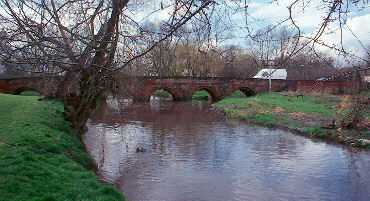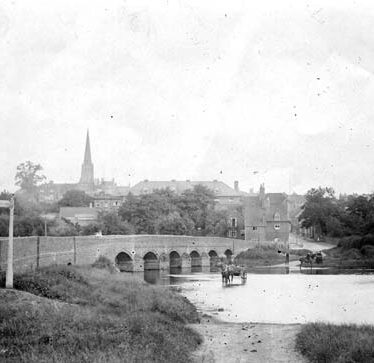Coleshill Bridge
Coleshill Bridge which was built during the Post Medieval period. It is constructed from sandstone ashlar and is situated at Cole End, Coleshill.
1 An ancient bridge. Although widened on the W in modern times it still forms a bottle-neck. It dates apparently from the mid 16th century and is built of red sandstone ashlar. It consists of 6 bays with semicircular arches showing 2 chamfered orders on the E face: the W face is modern. There are 5 piers with V-shaped cut-waters on both faces: the middle pier is entirely rebuilt, mostly of brick: some of the others have been repaired on the E face. The pier parapets, except above the middle pier, are slightly recessed, the tops of the lower parts of the V faces sloping back to them. Above the end arches the ashlar courses are sloped down to the original steep ramps, and later masonry is added above these courses at the N end. There are 3 further arches to the N under the causeway, of 17th or 18th century masonry, with cut-water on the E face.
2 A fine example of a Medieval bridge of the 15th or 16th century, having 6 segmental arches with double chamfered end-stones. There appears to be no documentary evidence for its date of building or its builder but no doubt Maxstoke Castle or Priory would provide a possible clue. It is almost double its original width of about 2.3 m having been widened upstream. A new bridge was built immediately upstream in 1938.
5 The E side has cutwaters with shallow flat refuges over them. It has been a good deal restored, two of the cutwaters have been rebuilt in brick, but this is not recent work. The arches are of two rings with chamfered arrises.
7 A stone bridge of six arches which has been widened on the west side. The east side has cutwaters with shallow refuges over them. It has been a great deal restored, two of the cutwaters have been rebuilt in brick, but this is not recent work. The arches are of two rings with chamfered arrises.
8 An archaeological evaluation involving trial trenching of deposits immediately east of the northern flood arches revealed a single undated posthole containing a decayed timber post of uncertain function. The timber post was sealed by thin alluvial layers and modern build up.
9 Archaeological observation at Coleshill Bridge recorded the foundations of the east ends of the two piers of the flood-arches north of the bridge.
10 Observation of a trench to the south of the bridge excavated by Severn Trent Water in September 1996 revealed the continuation of layers of alluvium and gravel.
11 Correspondence relating to scheduled monument consent from 1988.
- For the sources of these notes, see the
- Timetrail record
- produced by the Historic Environment Record.











Comments
Add a comment about this page